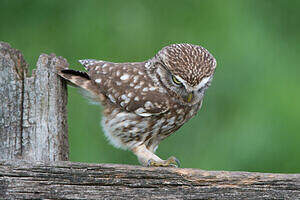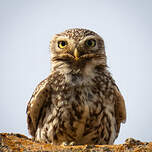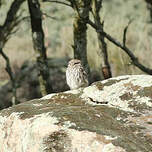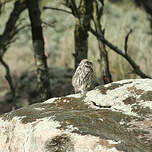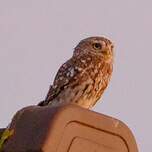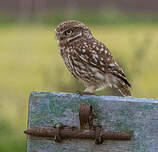Little Owl
Athene noctua - Chevêche d'Athéna
Identification
The Little Owl (Chevêche d'Athéna) is a small owl measuring a bit over 20 cm in length with a wingspan between 45 to 50 cm and a weight of around 200 g. It has a compact body, with a large head, short wings and tail. There is no sexual dimorphism, with the female simply being a bit larger than the male. The adult plumage is a brown speckled with white on top, and white with brown striations underneath. Its head is wider than high, with the sides curving around and a somewhat rectangular shape. The crown is brown, finely speckled in white. The facial disks of brown and white highlight the eyes which look like golden yellow, topped with white eyebrows, which form an X shape from the front, with a straw-colored beak in the middle. Interestingly, the nape of the neck also has a brown and white design which resembles the facial disks, so when the Little Owl turns its head 180 degrees, or has its back turned to us, it can seem like it is always watching us. This is a characteristic common to the family and must be an adaptation to deter potential predators. The wings and tail feathers appear barred. The tarses are white-feathered. The juvenile looks much like the adult, but with a more uniform plumage, less clearly marked and less "well-groomed". The facial mask is also less distinct. Color variations of the plumage vary greatly from one subspecies to another, of which there are 13. Birds in the northern parts of its range are darker than birds in the south, particularly of desert regions, which are often very light. The subspecies from Western and Northern Europe, vidalii, is the darkest, with lilith in the Middle East being the lightest.
Subspecific information 13 subspecies
- Athene noctua noctua (c, s and se Europe to nw Russia)
- Athene noctua vidalii (w Europe)
- Athene noctua indigena (Romania to Greece through Ukraine and Turkey east to s Russia)
- Athene noctua lilith (Cyprus, s Turkey to Iraq and the Sinai. Egypt.)
- Athene noctua bactriana (Iraq and Azerbaijan to Pakistan and nw India)
- Athene noctua orientalis (ne Kazakhstan, nw China)
- Athene noctua ludlowi (Himalayas)
- Athene noctua impasta (wc China)
- Athene noctua plumipes (Mongolia, sc Siberia and ne China)
- Athene noctua glaux (coastal n Africa to sw Israel)
- Athene noctua saharae (Morocco to w Egypt, c Arabia)
- Athene noctua spilogastra (e Sudan, Eritrea and ne Ethiopia)
- Athene noctua somaliensis (e Ethiopia and Somalia)
Foreign names
- Chevêche d'Athéna,
- Mochuelo europeo,
- mocho-galego,
- Steinkauz,
- kuvik,
- Steenuil,
- Civetta,
- minervauggla,
- Kirkeugle,
- kuvik obyčajný,
- sýček obecný,
- Kirkeugle,
- minervanpöllö,
- mussol comú,
- Kattugla,
- pójdźka (zwyczajna),
- mājas apogs,
- čuk,
- Домовый сыч,
- コキンメフクロウ,
- 纵纹腹小鸮,
- minervauggla,
- 縱紋腹小鴞,
Voice song and call
The vocabulary of the Little Owl is quite rich. She is particularly vocal at dusk during the breeding season. Territorial calls, alarm calls and others convey her activity. It is around small villages in the agricultural plains where you are most likely to hear it. The usual call is a powerful bitonal wiou. It is a warning or alarm call if there is an intrusion into the territory. It is somewhat reminiscent of the cry of the buzzard. The song is a rising, interrogative Haaaah of high pitch that carries far. There are also drawn-out wouuu that can have the same tone as the song of the Scops Little Owl, so there can be potential errors, barked miou, etc. It has been shown that the cries of the adult male can be heard up to 4 km in the plain without any obstacle.
Habitat
The Little Owl has three requirements to be present, open spaces for hunting, cavities for nesting and this in plain.
Behaviour character trait
The Little Owl is a sedentary bird, present all year round in its territories. This characteristic limits its distribution to regions capable of providing it with subsistence during the bad season, that is, regions without long lasting snow cover.
Hence its absence from the mountains and too high latitudes. Couples are perennial and live both literally and figuratively under the same roof. Debut emancipated birds move little from the birthplace, on average 20 km. The little owl is active quite early in the evening without being strictly diurnal. The best time to look for it is in the evening twilight when it begins to become active. It is often anthropophilic insofar as it awakens ancient buildings in the countryside as a diurnal shelter and/or as a nesting site. It does not fear Man but keeps its distance. It knows how to be discreet while remaining easily recognizable for someone attentive. Unfortunately, in this environment, cats can be a real problem for it. During the day, especially in southern regions, it is often seen perched in view on a mineral substrate, stone edifice, ruin, old wall, pile of stones, small rocky bar ... In winter, if it has the necessary calm, it willingly exposes itself to the sun's rays without being active.Flight
Dietfeeding habits
The Little Owl mostly hunts at dusk and in the early night. Although it is quite diurnal, it does not hunt during the day.
It feeds on invertebrates and small vertebrates, which it captures after scouting from a lookout post and quickly gliding towards its prey. It usually chooses a high position with an unobstructed view in order to maximize its chances of detecting prey. A small prey like an insect is taken directly with its beak, while a larger prey like a field mouse is taken with its talons. It sometimes hunts on open ground. But it does not practice hunting in flight like the Eurasian Hobby can do. It does not have the capacity for it. Its diet varies depending on the territories and seasons. It is mainly insectivorous, especially in the summer in a temperate region. Invertebrates make up 70 to more than 90% of it. Large insects such as large Orthopterans and earthworms are the top prey. Small mammals such as field mice complete it. But the list of potential prey is long. Even deliberately, but marginally, it consumes vegetable items such as grass and leaves, small fruits and seeds. As with all raptors, the indigestible remains of the prey are regurgitated through the mouth in the form of pellets called regurgitation pellets, whose size is in proportion to the size of the bird, that is, small.Reproduction nesting
The Little Owl is monogamous and, due to the sedentary nature of the species, couples are likely to be stable over time, perhaps even until the death of one of the partners. Sexual displays begin early, in the middle of winter, but the breeding season itself extends from March to August. There is only one nesting per year. For nesting, the Little Owl is cave-dwelling, that is to say it nests in a cavity. Like all other nocturnal raptors, it does not build a nest, the female simply laying her eggs on the substrate of the cavity, which can be of very variable nature.
The nesting sites are of two kinds, arboreal or rocky. Old, hollowed out trees are an ideal form for it, but human intervention, for example in the form of old orchards, often deprives it of cavities that form naturally from rotting wood, from a hole made by a woodpecker, or from an injury or branch section. The lack can be made up for with artificial nest boxes, which it adopts very well. Old buildings provide it with many opportunities, such as holes in the walls under the roofs, boxes, air vents, beam holes, hollow pipes...Where the classic sites are lacking, a simple hole in the ground, such as a rabbit or other large rodent hole, can be sufficient, or even a pile of stones, a mural of dry stones... The female lays 3-6 smooth, white eggs, laid 2 days apart. Incubation usually begins with the first egg laid, but sometimes the female waits until her brood is complete or almost so, resulting in either synchronous or asynchronous hatchings. Incubation, which is provided by the female fed by the male, lasts 28-33 days. After hatching, the female remains on her young for another 15 days, during which the male supplies food for the family.When they are 30-35 days old, young Little Owls will leave their nest but they will still depend on their parents for another month. Sometimes, young owls will leave the nest before they are able to fly, which increases their risk. According to a study in Germany, 58% of them will successfully reproduce. In Juillard's study in Switzerland, the success rate is 58.3%. On average about 70% of young Little Owls die during their first year. However, if they manage to survive their first year, they could live up to 20 years.Geographic range
The Little Owl's range covers the whole of Eurasia from the Atlantic to the Pacific in a continuous band, including temperate and Mediterranean regions. It is also present throughout the northern part of Africa and the Arabian Peninsula, albeit fragmented. It is well represented in the Maghreb and along the Nile Valley. To the north, it is naturally absent in the British Isles (where it has been introduced), Scandinavia, and most of Russia. Its southern limit is the line connecting the northern tip of Mauritania to Somalia.
Threats - protection
IUCN conservation status
concern
in the Wild
threatened
evaluated
The Little Owl of Athena was forced to suffer, in the developed northern countries of its range, the alteration of agricultural landscapes as they were known in the past. This is the case in our country and, to use the words of the French organization Vigienature, The species declined sharply in France in the second half of the twentieth century due to the deterioration of its habitat (reparceling, disappearance of meadows and hollow trees, urbanization). Collisions with cars are one of the main causes of mortality. But for the last 20 years, it has been given an increase of +91%. However, Vigienature states The spectacular increase in the abundance index of this species should be considered with caution, as it is based on small numbers, of up to 40 individuals detected per year. It is still an indication that the Little Owl, after a temporary emptiness at the end of the 20th century, is improving its situation a little. But at the same time, the introduced population from Britain is in decline. The Little Owl of Athena populations had declined in the 1960s, among other things, due to the use of organochlorine pesticides. Since then, these products have been banned and the species is doing better. For the moment, the species is not globally threatened at the world level. For Birdlife International, the population is stable. The size of the range and population is such that the species does not approach the status of a vulnerable species. But beware, the threats, in the strict sense, persist, not least the lethal car traffic that continues to increase. For this last factor, specific and necessarily expensive facilities would be necessary to force birds to fly higher and thus avoid vehicles. It is a bit utopian.
Sources of information
- IOC World Bird List (v14.2), Gill, F and D Donsker (Eds). 2024-04-18.
- La Chevêche d'Athéna Athene noctua dans la Réserve de Biosphère des Vosges du Nord, Génot Jean-Claude
- La Chouette chevêche, JUILLARD Michel
- Les rapaces diurnes et nocturnes d'Europe, M. Cuisin, P. Geroudet
- Avibase, Lepage Denis
- Birds of the World, The Cornell Lab of Ornithology
- xeno-canto, Sharing bird sounds from around the world,
Other sources of interest
 Specification sheet created on
09/07/2023 by Jean François
Specification sheet created on
09/07/2023 by Jean FrançoisTranslation by AI Oiseaux.net
© 1996-2025 Oiseaux.net
- Accipitriformes
- Aegotheliformes
- Anseriformes
- Apodiformes
- Apterygiformes
- Bucerotiformes
- Caprimulgiformes
- Cariamiformes
- Casuariiformes
- Charadriiformes
- Ciconiiformes
- Coliiformes
- Columbiformes
- Coraciiformes
- Cuculiformes
- Eurypygiformes
- Falconiformes
- Galliformes
- Gaviiformes
- Gruiformes
- Leptosomiformes
- Mesitornithiformes
- Musophagiformes
- Nyctibiiformes
- Opisthocomiformes
- Otidiformes
- Passeriformes
- Pelecaniformes
- Phaethontiformes
- Phoenicopteriformes
- Piciformes
- Podargiformes
- Podicipediformes
- Procellariiformes
- Psittaciformes
- Pterocliformes
- Rheiformes
- Sphenisciformes
- Steatornithiformes
- Strigiformes
- Struthioniformes
- Suliformes
- Tinamiformes
- Trogoniformes








